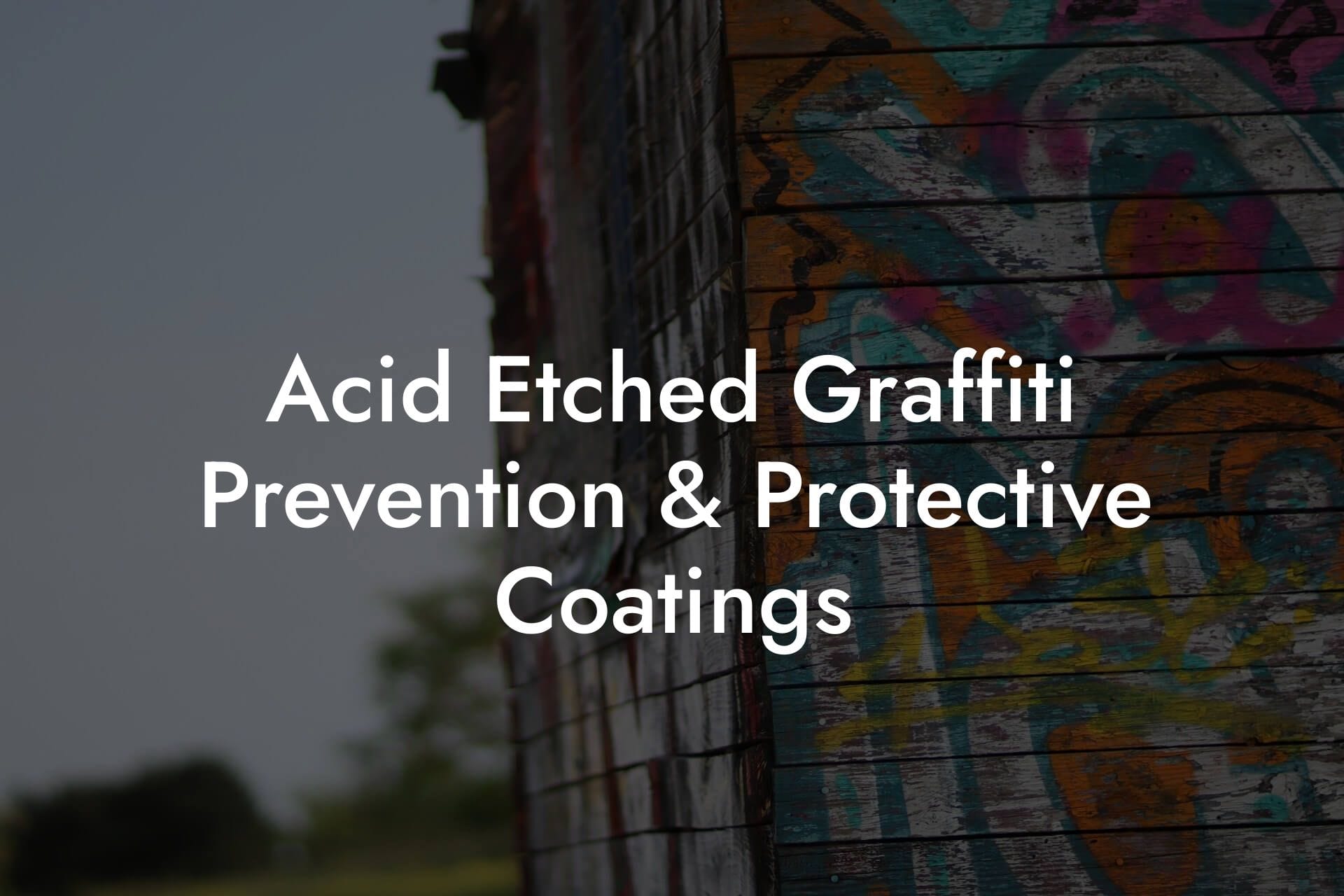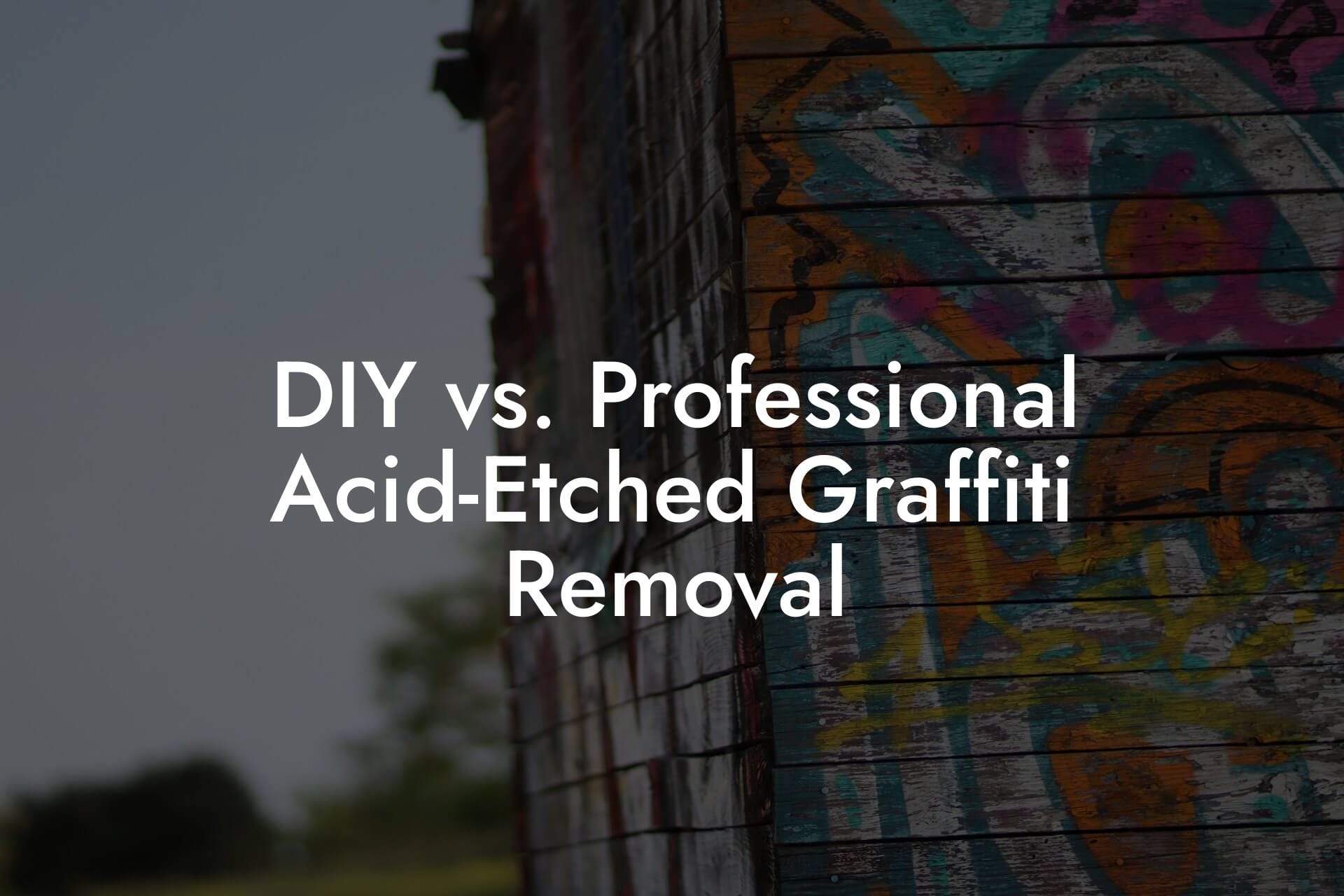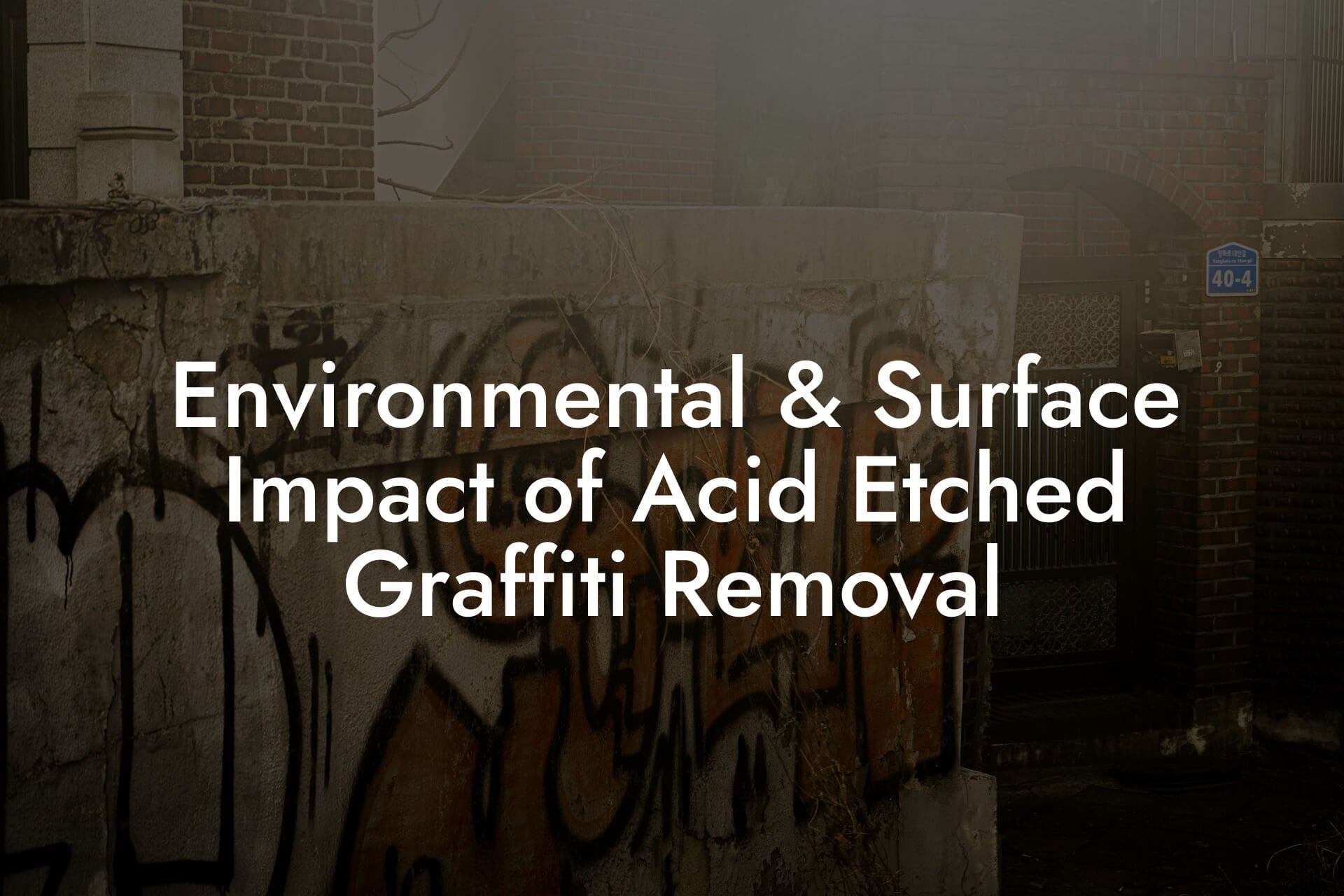Acid‑etched graffiti poses a significant threat to urban environments, defacing and degrading building materials in a way that ordinary paint removal cannot address. Unlike surface‑applied graffiti, acid eating into stone, concrete, metal, glass or ceramic alters the material’s chemistry and structure at a molecular level. This permanently scars façades, walls, pavements and decorative features, leaving property owners facing costly restoration or replacement. To fully combat acid‑etched vandalism, it is essential to understand both how vandals apply acids for etching and how professionals can reverse or mitigate the damage.
Table of Contents
- How Acid Etching Works and Why Removal Is Challenging
- Damage Assessment Procedures
- Mandatory Safety Protocols
- Alkaline Neutralization
- Chelation and Complexation for Metal Surfaces
- Micro‑Sandblasting
- Diamond Grinding & Polishing
- Laser Ablation
- Natural Stone Façades (Limestone, Sandstone, Marble)
- Concrete Retaining Walls & Underpasses
- Brickwork & Mortar Joints
- Glass, Ceramic Tiles & Mirrors
- Metal Surfaces and Stainless Steel Cladding
- Damage Assessment and Safety Protocols
- Chemical Removal Methods
- Mechanical Removal Techniques
- Hybrid Chemical‑Mechanical Strategies
- Material‑Specific Protocols and Case Studies
- Cost, Timeframes and ROI Considerations
- Preventive Maintenance and Long‑Term Protection
- Frequently Asked Questions
In this extensive guide, we explore every available technique for dealing with acid‑etched graffiti. You’ll learn how to assess damage, choose appropriate safety protocols, select the optimal removal method, chemical, mechanical or hybrid, and protect surfaces against future attacks. We will also review the specialized equipment and materials required, include multiple real‑world case studies, discuss costs and timeframes, and provide best‑practice recommendations for maintenance and prevention. By the end of this article, restoration teams, facilities managers and property owners will possess a complete toolkit for addressing acid‑etched graffiti effectively, safely and sustainably.
How Acid Etching Works and Why Removal Is Challenging
Acid etching involves applying strong mineral acids, commonly hydrochloric (HCl), sulfuric (H₂SO₄) or hydrofluoric (HF), directly to a substrate. These acids react with the substrate’s mineral or metallic compounds, dissolving or oxidizing the material and leaving a permanent mark. For example:
- On limestone or marble: acids react with calcium carbonate to create soluble calcium salts, carbon dioxide and water, effectively dissolving the stone’s surface.
- On concrete: acid attacks calcium silicate hydrates, forming gypsum and weakening the matrix.
- On metals: acid pitting removes protective oxide layers, leading to corrosion and rust.
- On glass and ceramics: hydrofluoric acid breaks silica bonds, leaving a frosted, rough pit that resists polishing.
This chemical aggression means that simply washing, brushing or painting over acid‑etched marks is ineffective. The damage resides within the substrate itself, requiring material removal, neutralization, or sophisticated restoration, far beyond conventional graffiti removal techniques.
Damage Assessment and Safety Protocols
Before any removal work begins, accurate assessment and rigorous safety measures are paramount:
Damage Assessment Procedures
- Visual mapping: Use raking light and high‑resolution photography to delineate etch boundaries and measure depth variations.
- Depth testing: Calibrated feeler gauges or digital micrometers quantify etch depth in millimeters.
- Chemical residue swabs: pH indicator swabs detect residual acidity; conductivity probes gauge salt contamination.
- Surface porosity analysis: Moisture meters and portable spectrophotometers assess substrate porosity and discoloration.
- Material identification: Identify substrate composition (e.g., sandstone, granite, brick, concrete, stainless steel, glass) to tailor removal methods.
Mandatory Safety Protocols
- All personnel must don full chemical‑resistant PPE: nitrile or neoprene gloves, acid‑resistant coveralls, face shields and goggles rated for splash protection.
- Respiratory protection with A2 cartridges or supplied‑air respirators for hydrofluoric acid or fine particulates during grinding.
- Local exhaust ventilation, dust‑capture hoods and HEPA‑filtered vacuums for mechanical abrasion to contain hazardous dust.
- On‑site first‑aid provisions: calcium gluconate gel for HF exposure, eye‑wash stations, emergency showers and spill‑containment kits.
- Compliance with UK COSHH and environmental regulations for handling, transport and disposal of hazardous waste (spent gels, acidic rinsates, spent media).
Chemical Removal Methods
Chemical approaches aim to neutralize residual acid and dissolve etch‑formed salts without excessive substrate loss.
Alkaline Neutralization
Applying alkaline solutions converts residual acid into harmless salts and water. Common neutralizers include:
- Sodium bicarbonate (baking soda) slurry: mix to a thick paste, apply at 5–10 mm depth over etched areas, cover with plastic film to maintain moisture for 30–60 minutes, then rinse.
- Ammonia (NH₄OH) solution: effective on acid‑weakened concrete; apply at 5% concentration, scrub gently, rinse thoroughly.
- Proprietary alkaline gels: specifically formulated for masonry, adhering to vertical surfaces; feature color‑change indicators that signal neutralization endpoint.
Repeat neutralization cycles until pH swabs read between 6.5 and 8.5. Thorough rinsing with deionized water prevents salt crystallization under protective coatings.
Chelation and Complexation for Metal Surfaces
On stainless steel, aluminum, copper or mild steel, etching leaves metal chlorides or sulfates that accelerate corrosion. Chelating agents bind these salts:
- EDTA (ethylenediaminetetraacetic acid): applied as a 2–5% solution, dwell time 20–30 minutes, soft nylon brushing, then rinse and neutralize.
- Citric acid formulations: milder, food‑grade chelators safe for adjacent substrates; effective at pH 3–4.
- Commercial metal‑safe cleaning gels: tailored for anodized or powder‑coated finishes, providing chelation without substrate etching.
After chelation, rinse with alkaline wash (sodium carbonate) and dry thoroughly before re‑passivation or recoating.
Mechanical Removal Techniques
Mechanical methods physically remove the etched layer, restoring substrate smoothness but sacrificing some material.
Micro‑Sandblasting
- Abrasive media: silica‑free glass beads, walnut shells, or aluminum oxide at 0.1–0.5 mm grit.
- Pressure range: 0.5–1.5 bar for delicate stone and brick; up to 2.5 bar for concrete and terracotta.
- Nozzle technique: maintain 5–10 cm distance, sweeping pattern at 30° to surface, avoid dwell spots to prevent pitting.
- Containment: attach dust‑capture hoods and HEPA vacuums; wet suppression optional to reduce airborne dust.
Ideal for shallow etches (<2 mm) on porous substrates; preserves surface profile when executed by experienced operators.
Diamond Grinding & Polishing
- Grinding wheels: segmented diamond cup wheels, starting with 30–50 grit, progressing to 100–200 grit.
- Polishing pads: resin‑bonded diamond pads, 400–3,000 grit, to restore natural lustre on marble, granite, terrazzo.
- Equipment: handheld angle grinders for small areas; floor‑mounted grinders for large floors and walls.
- Water feed: continuous to cool the stone and suppress dust.
Effective for deeper etches (2–5 mm) on hard stone and concrete; removes uniform layers but reduces overall thickness, evaluate thickness limits for heritage stone.
Laser Ablation
Pulsed laser systems (e.g., Nd:YAG, 1,064 nm) offer ultra‑fine precision:
- Parameters: 0.1–0.5 J/cm² energy density, 10–20 ns pulse duration, 10–50 Hz repetition rate.
- Spot size: 0.5–2 mm; scanning head ensures even coverage.
- Applications: delicate carvings, glass etching removal, ornate metal plaques.
Laser ablation vaporizes contaminant layers with minimal thermal damage to the substrate. High capital cost and operator training are trade‑offs.
Hybrid Chemical‑Mechanical Strategies
Combining neutralization and abrasion often yields the best outcomes for moderate to severe etches:
- Neutralize with alkaline gel to halt acid activity and soften surface matrix.
- After rinsing and pH confirmation, perform micro‑sandblasting or diamond grinding to strip the weakened layer.
- Conduct final polishing or laser finishing on remaining traces.
- Apply protective sealer or sacrificial coating to deter future attacks.
This sequential approach minimizes tool wear, reduces substrate loss and enhances efficiency on varied materials.
Material‑Specific Protocols and Case Studies
Natural Stone Façades (Limestone, Sandstone, Marble)
Porous carbonates require gentle yet thorough treatment:
- Step 1: Sodium bicarbonate paste neutralization under plastic sheeting for 45 minutes.
- Step 2: Micro‑sandblast with glass beads at 1 bar pressure, maintaining a 10 cm nozzle distance.
- Step 3: Fine diamond polishing (400–800 grit) on marble; skip polishing on rough sandstone.
- Step 4: Apply breathable silane sealer (penetrating <10 mm depth) to repel future acid.
Case Study: A Grade II‑listed Bath stone townhouse in Bloomsbury suffered 3 mm‑deep etches across bay columns. Following the above protocol, the team restored uniform appearance, retained stone thickness, and applied a clear siloxane sealer, completing work in two days with no disturbance to residents.
Concrete Retaining Walls & Underpasses
Mass concrete absorbs acid deeply; coarse grinding often needed:
- Neutralize with ammonia/bicarbonate wash, rinse.
- Diamond cup grinding at 50 grit to remove 3–4 mm of surface, then 100 grit for smoothing.
- Micro‑polish optional; sealed with acrylic silane hybrid coating for waterproofing.
Case Study: A North London subway underpass saw extensive acid pitting. Restoration crew neutralized, ground and sealed 75 m² of concrete in 48 hours, preventing recurrent tagging for over 12 months in monitored zones.
Brickwork & Mortar Joints
Brick and mortar behave differently under acid attack:
- Neutralize with sodium carbonate solution, rinse thoroughly.
- Micro‑sandblast using walnut shell media to preserve brick faces and mortar edges.
- Inspect mortar joints; repoint with lime mortar if acid breached deeper than 2 mm.
- Seal with breathable water‑repellent coating on brick faces.
Case Study: A Victorian terrace in Islington exhibited scalloped brick surfaces and crumbling mortar. After treatment, repointing, and sealing, the façades remained graffiti‑free for eight months under a maintenance contract.
Glass, Ceramic Tiles & Mirrors
HF etches on glass and ceramics can only be removed by abrasion or laser:
- Laser ablation for mirror panels and decorative ceramic murals.
- Rotary polishing with cerium oxide slurry and felt pads for window panes; slow, multi‑hour process on deep frosts.
- Replace small ceramic tiles when glaze breach exceeds 1 mm for uniform aesthetics.
Case Study: A public art installation of glazed tiles at a Southwark community centre was etched with political slogans. Laser ablation removed messages without replacing tiles, preserving artwork and saving 60% of total replacement cost.
Metal Surfaces and Stainless Steel Cladding
Metal etches cause pitting, require careful chemical and mechanical repair:
- Apply EDTA gel to bind chlorides; agitate, rinse and neutralize.
- Light micro‑abrasion with fine aluminum oxide media at 0.8 bar for pitting scars.
- Passivate stainless steel with citric acid dip, polish with non‑abrasive buff pads.
- For mild steel, grit blast to ISO Sa 2.5, prime with epoxy, topcoat with two‑pack polyurethane.
Case Study: Stainless steel panels at a Canary Wharf office lobby were etched in multiple spots. Within one day, the team chelated, micro‑abraded, passivated and polished panels, restoring showroom quality finish.
Cost, Timeframes and ROI Considerations
Removal costs vary by substrate, damage depth and method complexity:
- Chemical neutralization only: £15–£30 per m², 1–2 hours per m² including dwell time.
- Micro‑sandblasting: £40–£60 per m², 30–45 minutes per m².
- Diamond grinding & polishing: £80–£120 per m², 1–2 hours per m².
- Laser ablation: £200–£300 per m², equipment mobilization and operator costs included.
ROI emerges from avoided substrate replacement (often £150–£500 per m²), reduced downtime and extended asset life. Protective coatings (£5–£15 per m², annual reapplication) further enhance ROI by preventing future etches and reducing removal frequency.
Preventive Maintenance and Long‑Term Protection
- Regular Inspections: Quarterly walk‑arounds to spot early etch marks, address within 48 hours.
- Coating Renewals: Reapply sacrificial films annually; recoat silane/sealants every 3–5 years.
- Maintenance Agreements: Bundled service contracts for rapid response, discounted rates on recurring visits.
- Environmental Design: Lighting, CCTV with acid‑vapor sensors, physical barriers and community art to deter vandals.
Frequently Asked Questions
Can acid‑etched graffiti ever be fully erased?
Complete visual removal is achievable, but some substrate loss is inevitable. Skilled treatment can restore original appearance with minimal material removal, rarely exceeding 3 mm. Protected, sealed surfaces display long‑term resilience.
How quickly should removal begin?
Early intervention, within 24–48 hours, limits acid penetration depth, reduces restoration costs by up to 40%, and discourages repeat attacks by denying vandals a “lasting” mark.
Which method is best for historic façades?
Gentle micro‑sandblasting combined with alkaline neutralization is preferred to preserve original profiles. Diamond grinding and laser ablation may risk over‑removal on thin heritage stone.
Managing acid‑etched graffiti demands a multifaceted approach: thorough damage assessment, stringent safety protocols, and selection of the optimal combination of chemical neutralization, mechanical abrasion and protective sealing. By tailoring techniques to substrate properties and etch severity, restoration professionals can deliver high‑quality results while preserving material integrity. Complementing removal with preventive coatings, rapid‑response maintenance and environmental deterrents ensures long‑term protection. Equipped with the knowledge, tools and workflows outlined in this guide, DUA London and similar experts can safeguard urban assets, historic buildings and public installations from the permanent threat of acid‑etched vandalism.
Toby Doherty
Toby Doherty is a seasoned graffiti removal expert with over 20 years of experience in the industry. Throughout his career, Toby has helped countless businesses and property owners in London maintain clean, graffiti-free spaces. His extensive knowledge of graffiti removal techniques, from eco-friendly solutions to advanced technologies like laser cleaning, makes him a trusted authority in the field. Passionate about restoring urban environments, Toby combines his hands-on expertise with a commitment to staying up-to-date on the latest industry trends and innovations. When he’s not out in the field, Toby shares his insights through detailed articles, offering practical advice on everything from graffiti prevention to legal considerations.



